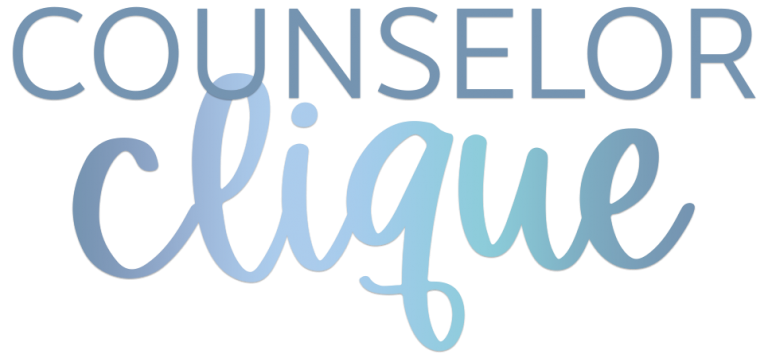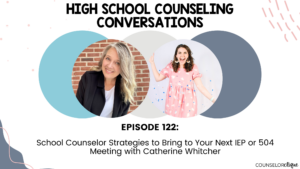For many counselors, just hearing the word data makes you start to squirm. This makes sense when you consider that most of us are wired to connect with people, not numbers. If a dewy finish is forming on your brow or your stomach just finished a sick somersault, give me a minute to explain how you can use data in your high school counseling program in an easy way that ensures compelling results. Don’t sprint to the back button on your browser, read on to learn how data is both a helpful and necessary advocacy tool that you can integrate into your program, no matter what your mathematical background.

Before I get into how to use data, start by downloading my free Data Collection guide here. This is a quick reference tool with 49 different places to look for data collection in your school. It’s like a treasure map that directs you to where to start digging. Here, I help you find data that already exists in your school in three categories: academic, behavior, and attendance. Believe me when I say this will be the MVP of your data collection journey.
Use data BEFORE the school year to inform the direction of your program
Before you get too deep into your school counseling practices for the year, gather your team members and utter the scary “D” word out loud. You’ll want to start conversations about the data you already have. Think about where you landed at the end of last year and consider:
- What trends were popping up? Did you notice any glaring gaps in attendance, grades, or discipline with your students?
- What goals did your administrators mention at the end of the year that are relevant to carry into this year? Are these goals data-driven?
If goals are a foreign concept in your administrator relationships, be sure to read some of my most popular blog posts on building better connections with your administrators to enhance your high school counseling program, here and here.
When it comes to how you use data, remember that you are the advocate for your students. Data prevents you from entering the school year blindly and helps you address gaps in your program. When you use data to identify how your students are struggling, the scaffolding for an effective school counseling program that tackles major issues begins to unfold.
Use data DURING the school year to establish trust within your school counseling program
Data is essential to a proactive and comprehensive high school counseling program. It informs where you start, how you get there, and where you finish. In my experience, when we had data to show what we were wanting to change, suddenly, people listened.
When we lacked the money to fund a new project and had numbers to back up the initiative, money appeared. When we needed support to pursue more time with students and less time counting test booklets, the data gave us validity for our cause. Data helps you speak the language of your stakeholders in a way that makes change possible.
Here’s how to do this throughout the year:
- Begin by referencing your needs assessment you have from the start of the year.
- Don’t miss the opportunity to collect data within your small groups. I have a small group data collection spreadsheet to help you do this with ease.
- Another great resource on how to use data in your program and share it with the world is ASCA’s “Making Data Work” book. I love having this resource on-hand to use throughout the year.
- Keep all of your data in a single place so you have it ready to share with others.
This brings me to an important point. Share, share, share your data. Then, share some more. Collect more data. And SHARE! Some places you can naturally tout your successful data points within your program include a school advisory council, faculty meetings, student support team meetings, and data action team meetings. You could even display compelling data about your program on a bulletin board in a high-traffic area. Sometimes people need a little reminding of how valuable you really are; data is the perfect advocacy tool. More on where to share data in this blog post.
And for my counselors who love to party: achieving your data-driven goals is cause for celebration. When we were clear about our goals, our teachers even celebrated with us. The numbers don’t lie! When you use data, you highlight your professionalism, your value, and your success in a way that people notice.
Use data AFTER the school year to highlight the overall success of your high school counseling program
When you sit back and relish the benefit of using data in an ongoing manner at the end of the year, numbers and stories speak where you can’t. The right data shared with the right crowd can change a perspective entirely. Use data to drive home the success of your program as you close out your school year (more tips on how to end the year on a high note, here).
Still feeling intimidated? Let me encourage you. School counselors package information and share it with others on a regular basis. Whether you’re distributing classroom lessons to students or announcements to parents, you’re taking information and making it digestible and useful to masses of people. Data is no different!
When it comes to data collection and sharing, the most important thing is to just start. It doesn’t have to be perfect at the beginning. This is an evolutionary process that will become more natural the more you do it. And when you start seeing the program-changing results, you’ll never go back to a counseling world without data at its center.
Listen to Episode 42 of High School Counseling Conversations for more of my thoughts on how to use data in high school counseling without overthinking it!
For more counseling encouragement and resources, be sure to join the Clique Collaborative, my high school counseling membership. Doors open twice per year (January and August), so snag a spot on my waitlist while you’re thinking about it.
Now… it’s time to dive into data. Let’s get collecting!






